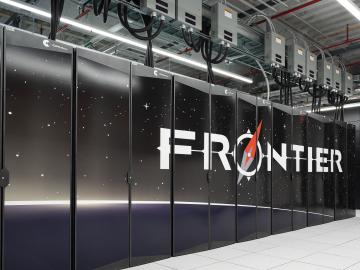Filter News
Area of Research
- Advanced Manufacturing (1)
- Biological Systems (1)
- Biology and Environment (12)
- Clean Energy (27)
- Climate and Environmental Systems (1)
- Fossil Energy (1)
- Fusion and Fission (8)
- Isotopes (1)
- Materials (35)
- Materials for Computing (3)
- National Security (8)
- Neutron Science (16)
- Nuclear Science and Technology (2)
- Supercomputing (17)
News Type
Date
News Topics
- 3-D Printing/Advanced Manufacturing (5)
- Advanced Reactors (3)
- Artificial Intelligence (5)
- Big Data (1)
- Bioenergy (3)
- Biology (7)
- Biomedical (1)
- Biotechnology (1)
- Buildings (3)
- Chemical Sciences (9)
- Climate Change (2)
- Computer Science (7)
- Coronavirus (2)
- Critical Materials (1)
- Cybersecurity (5)
- Decarbonization (5)
- Element Discovery (1)
- Energy Storage (15)
- Environment (7)
- Exascale Computing (3)
- Fossil Energy (1)
- Frontier (5)
- Fusion (3)
- Grid (6)
- High-Performance Computing (3)
- Isotopes (2)
- ITER (1)
- Machine Learning (3)
- Materials (16)
- Materials Science (8)
- Mercury (1)
- Microscopy (3)
- Nanotechnology (4)
- National Security (7)
- Neutron Science (9)
- Nuclear Energy (7)
- Partnerships (6)
- Physics (8)
- Polymers (3)
- Quantum Computing (2)
- Quantum Science (4)
- Security (2)
- Space Exploration (1)
- Summit (1)
- Sustainable Energy (5)
- Transformational Challenge Reactor (2)
- Transportation (6)
Media Contacts

Paul Langan will join ORNL in the spring as associate laboratory director for the Biological and Environmental Systems Science Directorate.

A new supercomputer breaking performance records, a mind-blowing physics experiment trying to spot dark matter and the groundbreaking for a new isotope facility were among Oak Ridge National Laboratory’s most popular news stories of 2022.

Jeremy Busby has been named associate laboratory director for the Fusion and Fission Energy and Science Directorate at the Department of Energy’s Oak Ridge National Laboratory, effective Jan. 1.

The Oppenheimer Science and Energy Leadership Program has selected Oak Ridge National Laboratory’s Jens Dilling and Christian Petrie as fellows for its 2023 cohort.

Seven scientists at the Department of Energy’s Oak Ridge National Laboratory have been named Battelle Distinguished Inventors, in recognition of their obtaining 14 or more patents during their careers at the lab.

Three researchers at ORNL have been named ORNL Corporate Fellows in recognition of significant career accomplishments and continued leadership in their scientific fields.

Scientists at the Department of Energy’s Oak Ridge National Laboratory are leading a new project to ensure that the fastest supercomputers can keep up with big data from high energy physics research.

While studying how bio-inspired materials might inform the design of next-generation computers, scientists at ORNL achieved a first-of-its-kind result that could have big implications for both edge computing and human health.

Researchers at ORNL have developed a new method for producing a key component of lithium-ion batteries. The result is a more affordable battery from a faster, less wasteful process that uses less toxic material.

Although blockchain is best known for securing digital currency payments, researchers at the Department of Energy’s Oak Ridge National Laboratory are using it to track a different kind of exchange: It’s the first time blockchain has ever been used to validate communication among devices on the electric grid.




